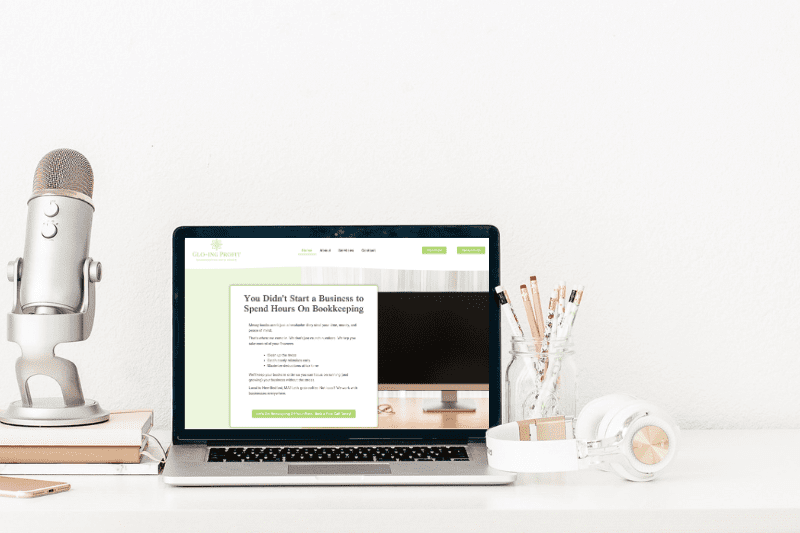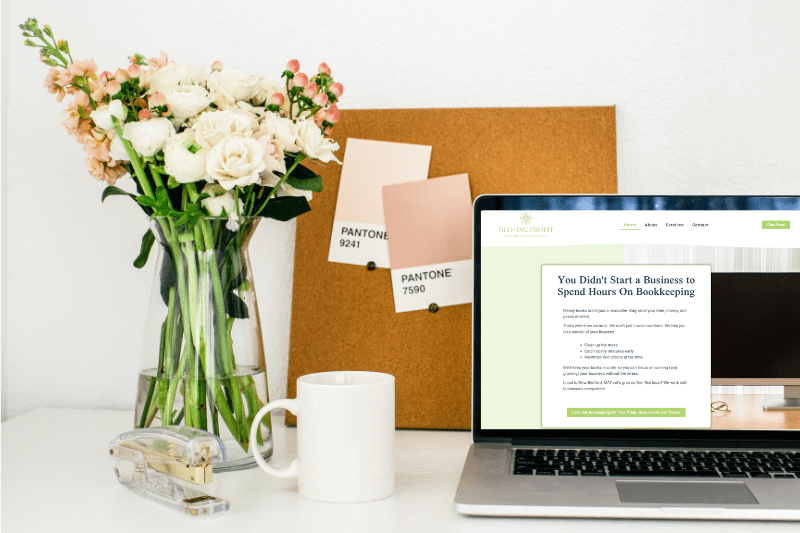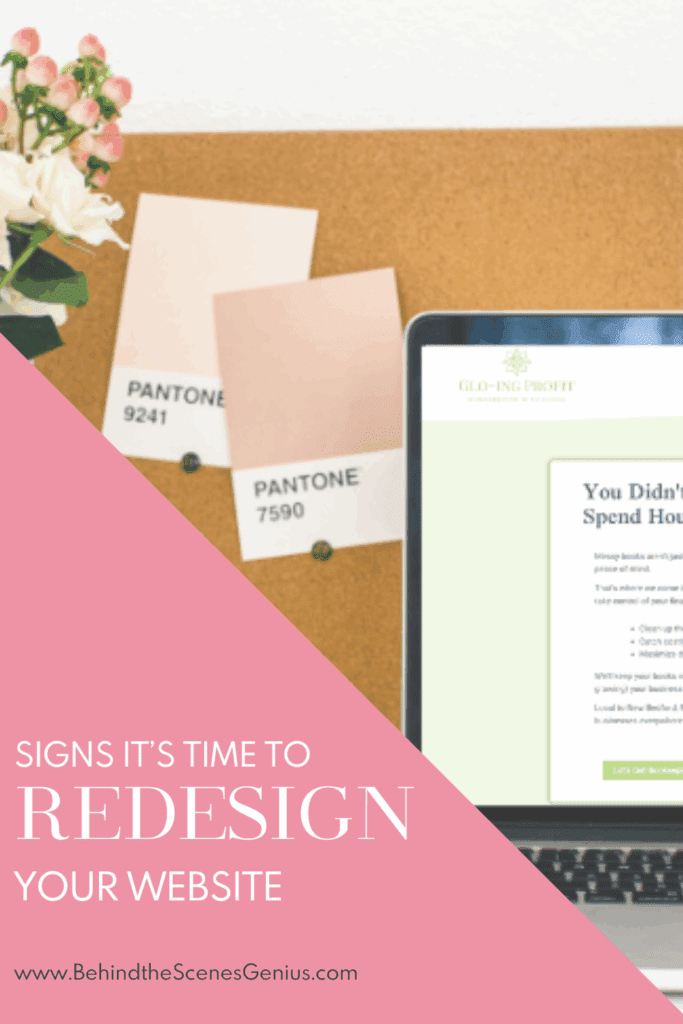Considering if it’s time to redesign your website but feeling conflicted? Your website isn’t just a box to check off on the list of credible business things to have. It’s not just another thing you feel are required or a nuisance to mess with. It’s a dynamic tool that can make or break your digital presence, can be a catalyst to help you grow. Or… it can end up being a glorified expensive digital business card… sitting there collecting dust. The difference is all in how you use your website and what you do with it. Whether someone discovers you through a search engine, social media, a podcast interview, or word-of-mouth, they’ll likely check out your site before reaching out.
It’s the place potential customers go to learn more, assess your credibility, and decide if they want to take the next step. And that’s why your website needs to clearly convey what you do, makes you look professional, and helps showcase your skills. A powerful website acts like your best salesperson. It should reflect your brand identity, support your business goals, and serve your audience well. If your current site isn’t doing that, it may be time for a redesign.
First: A Disclaimer
I would feel bad if I didn’t offer a disclaimer at first. If you’re new to business or at a stage of pivoting, your website may need to look a tad different. Let me explain a bit more.
Why? That is because the type of website you need will vary of the life of your business. If you’re new to business then you may be able to use a simple one page website. This is great for when you’re getting started and offering just 1 service to get your business off the ground. I will offer 1 exception to this one page website rule. Certain industries require a sense of professionalism and legitimacy. Industries like the legal industry, bookkeeper / CPA, construction, and more. The list can go on. There’s one thing to consider when deciding if you can have a simple one page site to get started or if you would be better served with a multiple page site. Does the average client of yours need to feel safe and secure in their decision to hire you? Generally, the greater the risk, the more information needed to make that decision.
And what about if you’re pivoting? This can be a stressful time in business, but also exhilarating. First, let’s define what a true pivot is… rather than niching down. Sometimes it’s a variation of what you’ve been doing in a new way, or something very different. Think of it this way… when Wrigley went from making soap to making chewing gum… Going from being a fitness coach to a food blogger and course creator, that’s a pivot. You may offer the same thing, in a different way. That’s a pivot. What pivoting doesn’t mean… refining your niche. Going from being a business coach to a business coach for female entrepreneurs making over 6 figures… that’s niching down.
In the case of a true pivot, I would recommend going with a more standard multi-page website. The one difference here, is that you’re not going to be needing an in depth website with professional copywriter level content and web designer creation. Or even the SEO for that matter. The goal is for your website to be clear about what you do while also looking as visually pleasing. A great website template could come in handy here. But why wait for that custom and professional website? Finish your pivot, get your business on it’s feet after the pivot, and then venture down that path.
With that said, let’s take a look at when it’s the right time to redesign your website.

Why a Website Redesign Can Be a Powerful Marketing Tool
A successful website redesign can be a great way to grow your business and put it to work for you. But to do this, it needs to fit into your overall business goals and marketing strategy. If your current site no longer reflects where you are as a business, or where you want to go, investing in a new website may be the right next move for you.
Your website is often the first impression your brand makes on a potential customer. It’s your digital storefront, your 24/7 salesperson, and one of the most powerful tools in your marketing toolkit. As your business evolves, your website should evolve too.
A website redesign isn’t just about aesthetics. It’s about strategically improving your online presence to:
- Reflect your current brand identity
- Align with your marketing goals
- Enhance user experience
- Improve your search engine visibility
- Support your sales process
Whether you’re rebranding, adding new services, ready to move into growth mode, or simply noticing that your site no longer feels “like you,” a thoughtful redesign can elevate your entire business and become another member of your team that works for you 24/7.
Signs It’s Time to Redesign Your Website
Let’s walk through the most common signs it’s time to invest in a website redesign. This way you can assess if it’s the right move for you, or if you should take another route.
1. Your Website No Longer Reflects Your Brand
Your brand isn’t just your logo—it’s your voice, tone, values, messaging, visuals, and how you show up online. As your business grows and evolves, your brand naturally shifts. If your website still reflects your old brand, it can create confusion and inconsistency.
This is especially important if you’ve undergone a visual rebrand, refined your target audience, or refined your offers. Your website should reinforce trust, not raise questions.
2. Your Website Isn’t Mobile-Friendly
With mobile devices accounting for more than half of all website traffic, a mobile-responsive website isn’t optional—it’s essential.
If your site is difficult to navigate on smaller screens, loads slowly on phones, or doesn’t adjust properly for tablets, it could frustrate potential customers and negatively impact your search engine rankings.
3. Your Website Is Difficult to Update
A website should be easy for you, or your team, to update regularly. Being able to make small changes, tweak copy, or run a special on something can be time sensitive. If you rely on a developer for every minor text edit, or if your current platform feels clunky and outdated, it’s time for an upgrade.
Modern platforms like WordPress with visual builders like Elementor make content management more intuitive and efficient. It’s also a great idea when you talk to a website designer, to make sure that it’ll be something easy for you to use. Additionally, if you’re in a position to be able to afford a monthly website maintenance fee, you may want to talk to your designer about what this may include.
4. Your Website Has a High Bounce Rate
A bounce rate measures how many people leave your site after visiting only one page. If your analytics show high bounce rates, it could indicate:
- Confusing navigation
- Slow page load times
- Poor user experience
- Outdated design or content
- Lack of clear calls to action
Redesigning with best practices in mind can help keep visitors engaged and guide them toward taking action.
5. Your Website Is Outdated Visually or Technologically
Visual trends evolve. What looked cutting-edge even 2 years ago may now appear stale or unprofessional. Some design trends come and go in a matter of a year or less. Some designs even become stale when they’ve not been updated for years. Making it clear that you’re website hasn’t been updated in some time, often making potential clients fear that the information may be outdated. But it’s not only about looks.
Behind the scenes, outdated websites may also:
- Use unsupported code or plugins
- Lack accessibility features
- Perform poorly on search engines
- Fail to meet today’s security standards
A redesign ensures your site stays functional, secure, and modern. Which all end up helping your audience have a more pleasant experience on your website.
6. Your Website Isn’t Aligned With Your Business Goals
Your website should support the direction your business is heading. If your services, offers, or audience have changed, but your website hasn’t, you’re likely missing opportunities. A new design gives you the chance to realign your content, visuals, and structure with your updated goals. In addition, it can also provide you the opportunity to further your business growth by
7. Your Website Is Missing Important Features
If your current site lacks features that improve the user experience or help you convert visitors into clients—like online booking, lead capture forms, case studies, interactive tools, or testimonials—it may be time to invest in a new website.
Today’s sites should support your workflows and marketing, not just act as static pages. It should be a valued member of your team that works for you while you sleep, answering questions, showing your potential clients what you’re capable of, and how they can work with you.
8. Your Website Isn’t Showing Up on Google
If you’re not showing up in search engine results for relevant keywords, your site may not be optimized for SEO. This could be due to:
- Poor site structure
- Missing meta descriptions and title tags
- Slow load times
- Lack of mobile responsiveness
- Outdated content
A redesign focused on search engine optimization can significantly improve your visibility.
9. You’re Embarrassed to Share Your Website
If you hesitate to send someone to your site, it’s a clear sign something’s off. Your website should be a source of pride—a place that represents you well and makes your business look credible, trustworthy, and professional.
If you’re constantly making excuses or redirecting people to your Instagram or LinkedIn instead, it’s time for a fresh start.

Recognizing the Limitations of Your Current Site
Sometimes it’s hard to pinpoint exactly what’s “off” about your current site, but you know something’s not working. Maybe you’ve outgrown your DIY design or previous template, your conversion rate is lower than expected, or visitors aren’t engaging with your content. Or maybe you’re ready to take what’s currently working well, and get it to work harder for you.
A strategic redesign starts with identifying what’s not working and what needs to change. But it’s more than just fixing what’s not working. When it really comes down to it, it’s about starting at the top and redesigning it to meet newer, more updated standards.
This can include:
- Clarifying your messaging and user journey
- Improving your navigation and user interface
- Reworking your calls to action and lead flows
- Working with a copywriter for more clear cut website copy
- Hiring a photographer for a fresh and updated brand identity
When you redesign with these goals in mind, you create a stronger foundation for long-term growth.
Building a Better Online Experience
User experience (UX) is everything. A confusing layout, hard-to-read fonts, or broken links can frustrate users and send them elsewhere. And slow load time’s can also send them running for the hills. These small little things can all add up to create a more enjoyable (or not), user experience.
During a redesign, you want to make sure that your designer is considering things like:
- What information does your target audience need first?
- How can they be guided to take action?
- Are all visual elements, content structure, and calls to action clear?
- Does your website clearly convey to your potential clients that you’re trust worthy?
Great UX leads to increased engagement, better conversion rates, and stronger brand loyalty.
Embracing Strategic Design Decisions
Design should be beautiful, yes, but it should also be strategic. Every design element needs to work together cohesively. When it comes to website design, the copy needs to be written first. Not only is it easier to design the website to fit the copy, it’s also far more visually pleasing. But beyond that, there’s also the visuals. When it comes down to it, every design element should work together to cohesively reflect the vibe, feel, mood, and tone of your brand.
The other visuals to consider include things like:
- Using a color scheme that reflects your brand personality, there are many thoughts and methods to this, but consulting with a brand designer is best
- Choosing fonts that are legible and appropriate for your industry, again, consulting with a brand designer is the best scenario
- Incorporating images and graphics that enhance (not distract from) your message, having quality on brand photos is the best option here, but quality stock photos work well
- Designing for accessibility and mobile responsiveness
A strategic design helps guide users where you want them to go—and creates a memorable impression. Every element of your website tells a story. From the colors and fonts to the photos and even the layout. It all tells a cohesive story about your brand and invites your potential customers in.
What to Expect From the Website Redesign Process
Redesigning your website can feel overwhelming, but with the right team and plan, it’s a smooth and rewarding process. It’s important to make the distinction that a website redesign is starting fresh on the entire website. Whereas a website refresh is more of a slight design revision to make some more minor updates. While every website is unique, the general process is much the same.
Here’s a general outline of what to expect:
- Audit & Discovery – Assess your current site, review Google Analytics when available, and identify what’s working and what’s not. As well as defining the goals, audience, and design style.
- Gathering of Resources – This phase can also be done at the same time as the first or shortly thereafter. In this phase we gather all the elements needed, website copy, photos, and any other visual elements.
- Design Phase – We start by creating mockups based on the audit and discovery phase as well as the resource gathering. All of these combine to help determine the mockups of the website in phase one.
- Development – Next we build the site based on the mockups and your feedback and we optimize for SEO at this phase.
- Edits, Launch & Training – We’ll go through 2 rounds of edits for your feedback on the website, then we’ll go live with the design and cover any needed training afterward.
A great website redesign partner will keep you involved at each step, ensuring the final result works for both your business and your audience.
Making the Most of a Website Redesign
A website redesign is an opportunity to take a step back and evaluate how your online presence supports your entire business. It’s a chance to evaluate how you’re using your website, what it’s been doing for you currently, and how you can better utilize it.
Don’t just focus on how the site looks—think about how it functions:
- Is your website supporting your sales funnel?
- Are you speaking to the right audience?
- Is it easy for people to find what they need?
- Are your SEO foundations strong?
- Do your visuals reinforce your brand identity?
A thoughtful redesign is more than a facelift—it’s a foundation for growth. Because when it comes down to it, you’re website is the digital storefront of your brand. You can have all the social profiles and followers you want. But if those were to go up in flames tomorrow, how else would your new and potential clients find you? Your website is the best place to send them. When you send your clients to your website and you then offer those people to join your world, like by signing up for your email list, that is gold. That right there is how you own access to your current and potential clients.
Why a Website Redesign Is a Strategic Investment
A well-designed website can increase your conversion rate, improve your visibility in search engines, and support your long-term business goals. It’s not just about how the site looks—it’s about how well it works for your team and your audience. It’s about what it does for your business growth and how it supports and helps your current and potential clients. A well-designed website can be the foundation of another team member that works for you 24/7.
When done right, a redesign can:
- Streamline your operations
- Reduce time spent answering repetitive questions
- Attract better-fit clients
- Improve your online presence
- Serve as a central hub for content, offers, and resources
You don’t need to redesign your site every year, but when your current site is holding you back, it’s one of the most impactful changes you can make when it’s done at the right time. Simply redesigning your website because you think you need to or you feel bored with the style, isn’t the time to do it. The time is when a pivotal change is happening, like rebranding, creating new services, or niching down.

FAQs
How often should a website be redesigned?
Most businesses benefit from a redesign every 2–4 years. However, the right timing depends on how quickly your business evolves, how often you update your content, and whether your site is still meeting your goals. It also depends on things like how fast your business grows. If you’re business is growing at a faster pace and you need to redesign your website, then you may need it more than someone who’s growing at a slower pace.
What’s the difference between a website refresh and redesign?
A refresh updates your existing site, changing fonts, colors, photos, or some content. Overall a refresh doesn’t change the main site structure, it sticks with the existing layout and style and makes small tweaks. A redesign is a deeper overhaul, often including new layouts, functionality, branding, and structure. This goes deeper, affecting every page of the website in the process and starting with a strategy before touch a single element on the new website.
How do I know what’s working on my current site?
Tools like Google Analytics and heatmaps can help you see where users are dropping off, which pages are most popular, and what’s driving conversions. A designer or strategist can help interpret this data. It’s important to make sure that you have Google Analytics running for some time on your website to gather a good amount of data for reference, the more traffic to your website the more data. Another helpful too is Google Search Console. This can give you insight into how your website pages are ranking on Google for SEO.
Will redesigning my site affect my SEO?
It can, but that’s not always a bad thing. If your current site is poorly optimized, a redesign can boost your rankings. Just be sure to work with someone who understands SEO best practices and implements redirects correctly. Don’t fret about you SEO rankings, often times with change it can take Google some time to adjust things and for rankings to even out. This is why it’s important that you’re designer makes sure your Google Search Console is working on the new website, so you can monitor rankings before and after the change, and watch for the rankings to level out.
How long does a website redesign take?
Timelines vary, but a strategic redesign often takes 2-4 months depending on complexity, content needs, and features. It also varies depending on the other needed elements, like copy and photos. If you’re planning to work with a copywriter and a photographer it’s best to do those before you even venture into a conversation with a web designer. The timeline can also vary depending on the number of pages you’re needing as well, more pages will require more copy and more time to design.
Do I need to hire a design team or can I do it myself?
That depends on your skill set, time, and the complexity of your site. A professional designer can ensure your new website is strategic, effective, and aligned with best practices. It’s important though to check out the disclaimer near the top though. You may benefit from a one page website or starting with a website template to get started or upgrade your website if a custom designed website isn’t right for you just yet.
What content do I need to provide for a website redesign?
You’ll typically need to provide updated text, brand assets (like your logo and color palette), imagery, and any specific messaging or calls-to-action. A strategic design partner can also help guide content development and recommend ways to improve your messaging.
Can I redesign my website in stages?
Yes, a phased redesign approach is often a smart strategy for businesses with limited time or budget. You can prioritize updates based on impact—such as homepage and navigation first—then roll out additional features or pages over time. Depending on how much your website is going to be changing, the approach may not work the best. If you’d like to take a phased approach, start by talking to your website designer and making them aware of your budget.
Will my website be down during the redesign process?
In most cases, your current site can remain live until the new design is ready to launch. Designers typically work on a staging site or hidden development environment so your users won’t experience any downtime. At the time of the website going live there may be some minor downtime, just how long depends on a number of factors. But you’re designer can advise you on how long your site may be down at the time of launch, in most cases it’s minimal.
What happens after the new website launches?
Post-launch, it’s important to monitor performance through tools like Google Analytics and Google Search Console. From here, if desired you can make any necessary tweaks. At the time of launch it’s also wise for your designer to ensure all integrations (forms, CRMs, etc.) are functioning properly. Ongoing maintenance and updates help keep your site secure, fast, and aligned with business growth. It may be wise to discuss an ongoing website maintenance plan with your designer. This can keep your website updated and secure. And, your designer may have a plan that includes a set amount of time per month for any website edits or tweaks.
Final Thoughts
If your website no longer reflects the quality, growth, or direction of your business, it might be time to hit refresh. It also may be time to redesign your website if you’re ready to start growing your business more and you want to capitalize on what’s working, while maximizing the effectiveness of your website. A website redesign is an investment, not just in how your business looks online, but in how it functions, connects with your audience, and helps you grow. And a well built website is also going to be the foundation of another team member that works for you 24/7. All you have to do at this point is feed the right customers into your website and utilize where they go on the backend, allowing you to grow your business without having to do as much manual labor on every step.
Whether you’re making a pivot, dealing with low conversion rates, or faced with an outdated design elements, a new website can open the door to more visibility, better engagement, and bigger business results.
If you’re ready to get started, let’s talk about your website. A free discovery call starts the process where we can talk about your business goals and your current website, and how we an bring it all together with a strategy that sets the foundation of business growth.

